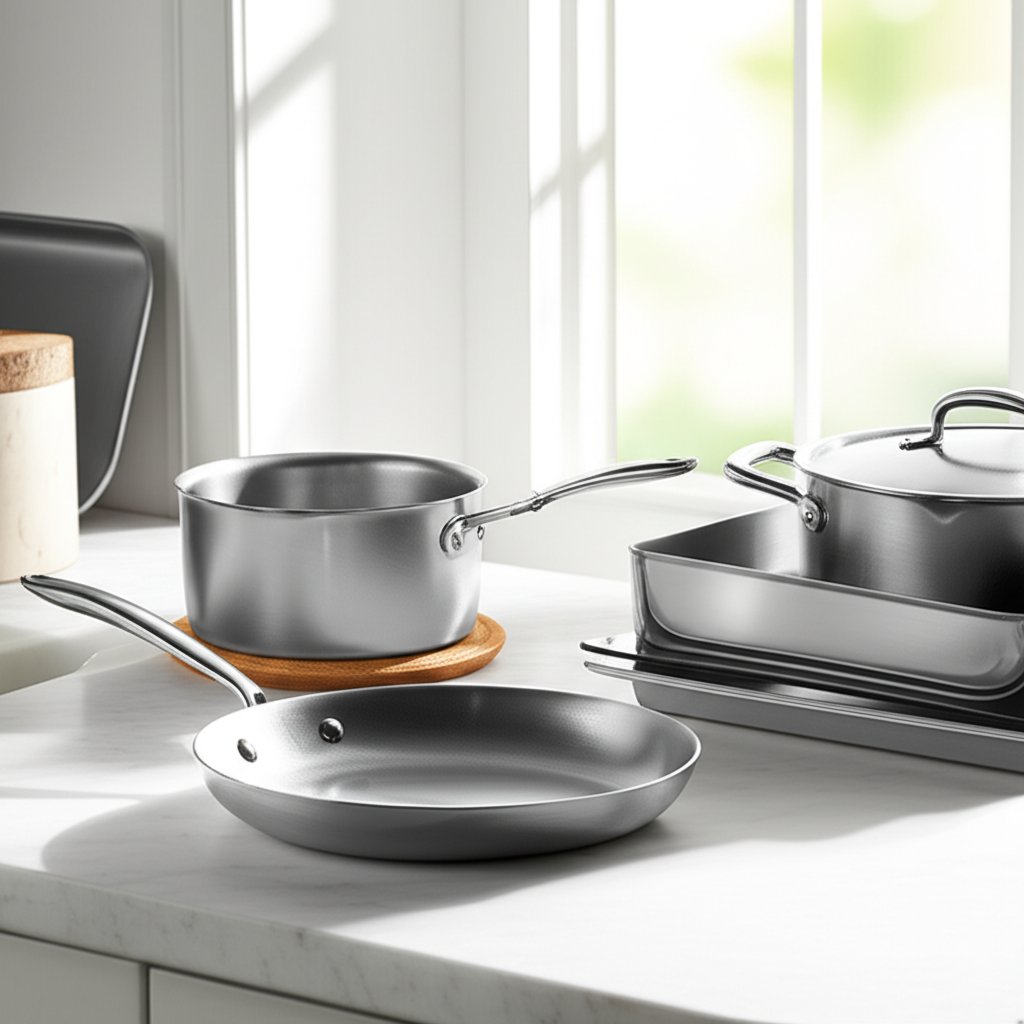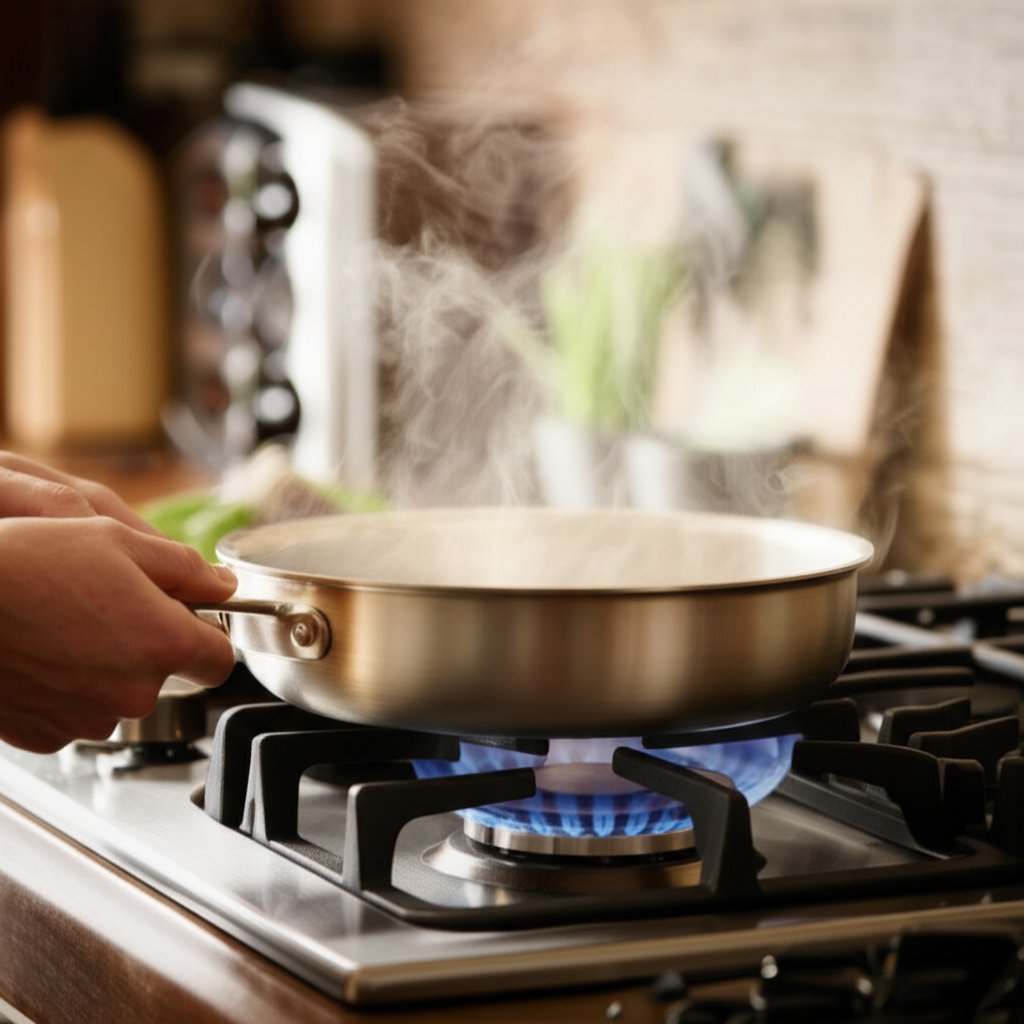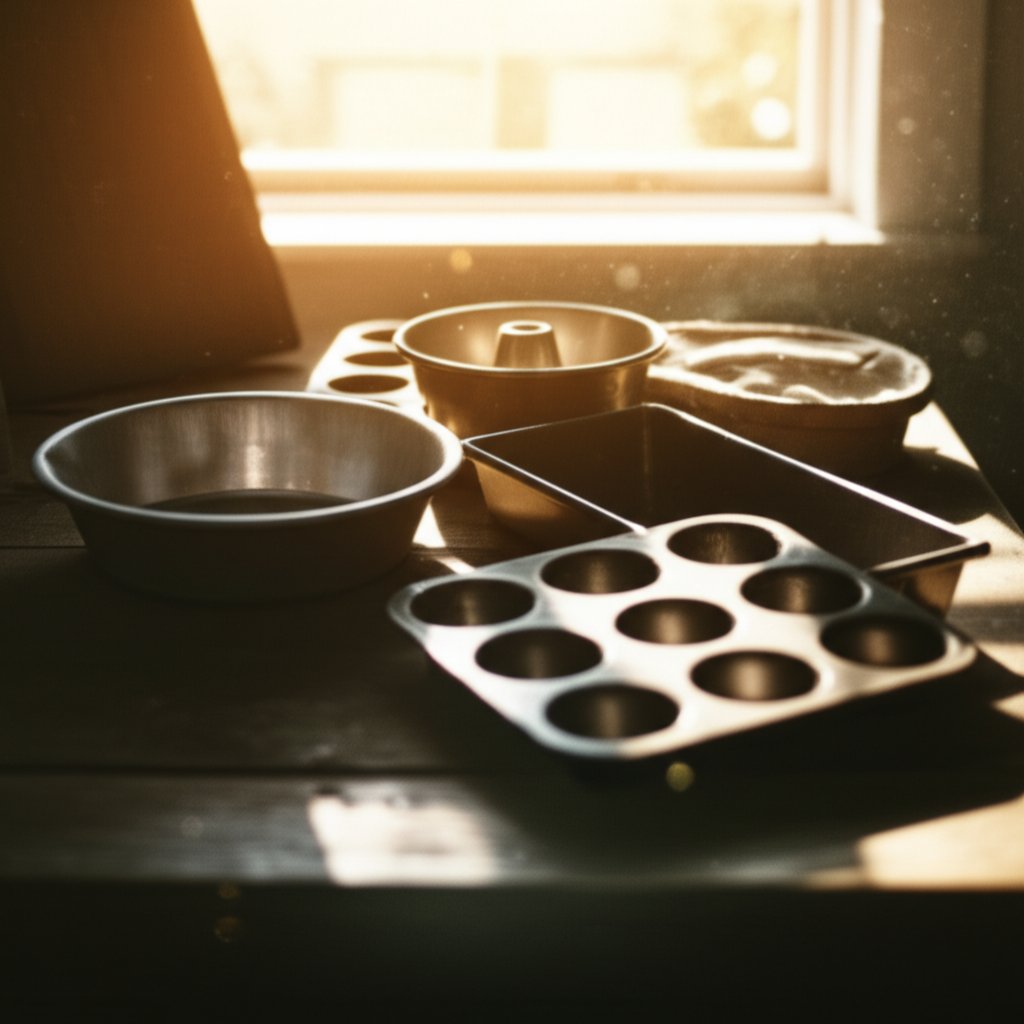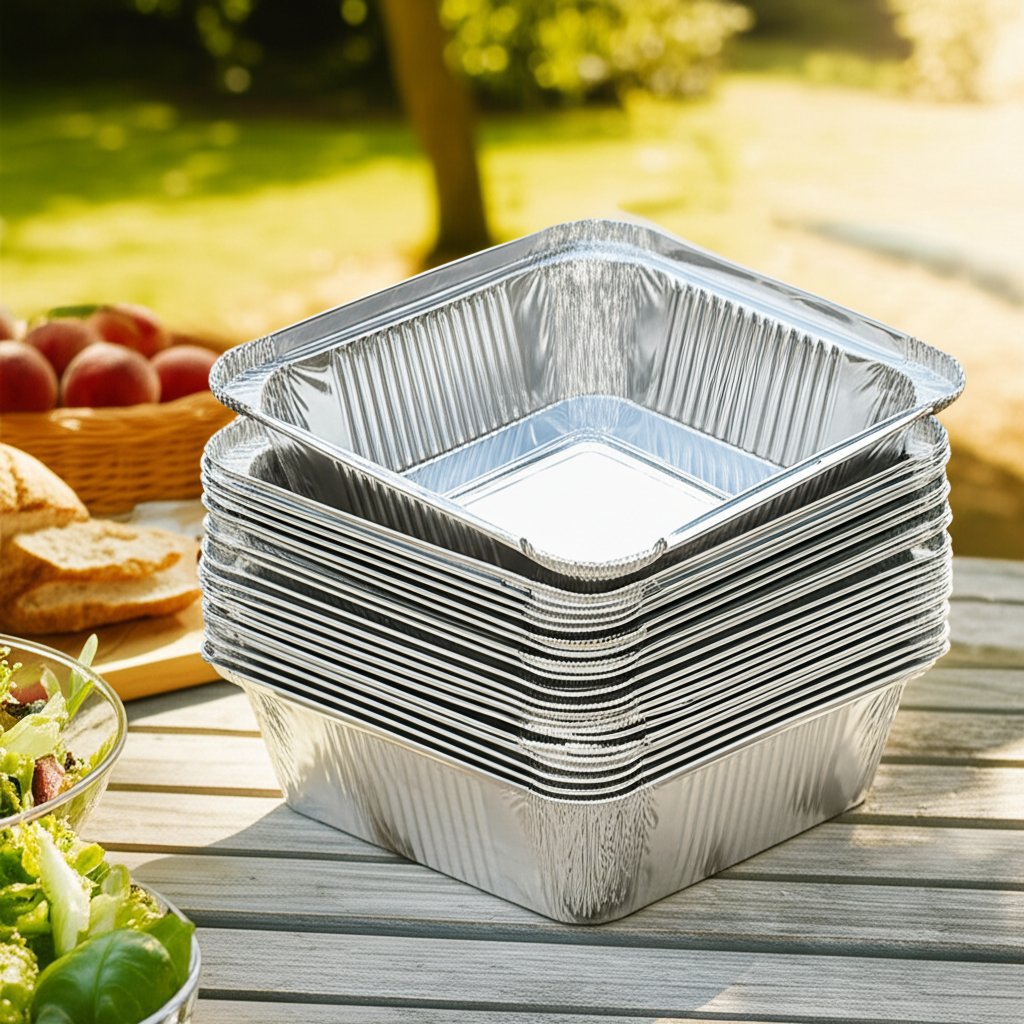
When you open your kitchen cabinet, what’s the first pan you reach for? If you’re like most home cooks or professional chefs, it’s likely an aluminum pan. But why are aluminum pans such a staple in kitchens around the world? The answer is simple: they offer a unique blend of excellent heat conductivity, lightweight convenience, and affordability that’s hard to beat.
Imagine whipping up a quick stir-fry or simmering a hearty sauce. You’ll notice how aluminum pans heat up rapidly and distribute warmth evenly, helping you avoid those frustrating hot spots that can ruin a meal. This makes them perfect for everything from frying eggs to baking cakes. Their lightweight design means you won’t struggle to lift a full pot of soup, and their budget-friendly price makes high-quality cookware accessible to cooks at every level.
But the story of aluminum cookware doesn’t end there. Over the years, innovations in manufacturing have led to a diverse range of aluminum pans, each designed for specific tasks—from everyday frying pans to specialized baking pans and even disposable options for convenience. With so many choices, selecting the right aluminum pan can seem overwhelming. Sounds complex? Don’t worry—we’ll break it down for you.
In this comprehensive guide, you’ll discover:
Whether you’re a new home cook or a seasoned chef, understanding the strengths and considerations of aluminum pans will empower you to make informed choices in your kitchen. Let’s unlock the full potential of aluminum cookware together.

Ever wondered why aluminum cookware has held its place as a kitchen favorite for generations? When you reach for a pan that heats up quickly, feels light in your hand, and doesn’t break the bank, you’re experiencing the core benefits that have made aluminum a go-to material for cooks everywhere. Let’s explore what sets aluminum cookware apart and how it has evolved into a trusted staple on stovetops worldwide.
Imagine you’re preparing a delicate sauce or searing vegetables for a quick stir-fry. You need a pan that responds instantly to temperature changes and distributes heat evenly, preventing burnt spots or undercooked sections. That’s where aluminum cookware shines. Here are the key aluminum pan benefits that keep cooks coming back:
Aluminum’s story in the kitchen is one of innovation and accessibility. Originally, aluminum was rare and even more valuable than gold, reserved for royalty and special occasions. Napoleon III of France famously prized aluminum cutlery over gold at his imperial table, highlighting its early exclusivity. But as industrial processes advanced—most notably the Hall–Héroult process in the late 19th century—aluminum became more widely available and affordable. By the early 1900s, it was being used for everything from jewelry to household goods, and soon after, for cookware that would revolutionize home kitchens.
Today’s aluminum cookware benefits from decades of technological progress, not just in the kitchen but across industries like transportation and rail transit. Advanced manufacturing techniques ensure that the aluminum used in cookware is pure, durable, and precisely formed. Processes such as anodizing and high-tech surface finishing make pans more resistant to corrosion and easier to clean. These same standards are used in critical applications—think of the aluminum components in high-speed trains—where strength and reliability are non-negotiable. The result? Aluminum pans that are not only practical and affordable, but also meet rigorous quality and safety standards.
So, the next time you reach for your favorite aluminum pan, remember: you’re holding a piece of culinary history that’s been refined by centuries of innovation. But what types of aluminum pans should you have in your kitchen? Up next, we’ll break down the most common varieties and how to choose the right one for every cooking task.
When you open your cabinet and see a collection of pans, do you ever wonder which aluminum cooking pans you really need? With so many shapes and sizes, it’s easy to feel overwhelmed. But once you know the primary types and their uses, picking the right pan for your next meal becomes a breeze.
Aluminum pans come in a variety of forms, each designed for specific cooking tasks. Here’s a rundown of the most common types you’ll find in both home and professional kitchens:
Still not sure which pan suits your needs? Consider what you cook most often. If you’re a fan of one-pan meals, a large skillet or sauté pan might be your best bet. For avid bakers, investing in a set of aluminum baking pans of different sizes will help you tackle everything from birthday cakes to lasagna. And if you’re hosting big family dinners, a roomy stockpot or roasting pan will make meal prep much easier.
Remember, you don’t need every type at once. Start with the basics—a frying pan, a saucepan, and a baking pan—and expand your collection as your cooking style evolves. Each of these aluminum pans brings its own strengths to the table, making everyday meal prep smoother and more enjoyable.
Now that you know the essential types of aluminum pans, let’s dive into the world of specialized baking pans and discover why aluminum is the secret ingredient for perfect pies, cakes, and more.

Ever pulled a cake from the oven only to find it overbaked on the edges and raw in the center? Or maybe your pie crusts never seem to brown just right? If you’ve faced these baking frustrations, you’re not alone. The secret to more consistent bakes often lies in your choice of pan—specifically, aluminum baking pans.
When you want cookies that brown evenly, cakes that rise tall, or pies with a perfectly crisp crust, aluminum pans are a top pick. But what makes them so reliable? It all comes down to heat conduction. Aluminum is an excellent thermal conductor, which means it spreads heat quickly and uniformly across the pan’s surface. This helps avoid hot spots, so your baked goods cook through at the same rate—no more burnt bottoms or underdone centers. Whether you’re baking in a static or ventilated oven, aluminum pans adapt well and can be placed on any shelf, letting you control crust and base texture with ease (Contital).
Let’s break down the most common types of aluminum baking pans found in home and professional kitchens. Each is designed for a specific kind of bake, and knowing when to use them can take your results to the next level:
Still wondering what difference aluminum makes? Imagine baking a batch of cookies on a sheet pan. With aluminum, the cookies spread and brown evenly—no burnt bottoms or pale centers. Cakes rise with a flat, even top, making decorating a breeze. Pies come out with a crisp, golden crust, and muffins pop out of the pan with a perfect dome. This reliability is why professional bakers and home enthusiasts alike keep reaching for aluminum baking pans.
“Aluminum pans distribute heat evenly, guaranteeing perfect cooking in all types of traditional ovens.”
Beyond performance, aluminum pans are also available in various shapes, sizes, and thicknesses, letting you match the pan to your recipe. Some feature non-stick coatings or reinforced rims for added durability and easy release, while others are designed for single-use convenience.
Ready to explore the ideal pan size and features for your next bake? Up next, we’ll guide you through choosing the right aluminum pan for every recipe and occasion.
Ever found yourself staring at a shelf of aluminum pans, unsure which size or style to pick? Whether you’re baking a single loaf of bread or roasting a feast for a crowd, selecting the right aluminum pan size and features can make all the difference in your cooking results. Let’s break down how to match your pan to your needs, and what features can help you cook smarter—not harder.
When it comes to aluminum pans, size truly matters. Small aluminum pans are perfect for quick meals, individual servings, or side dishes. They heat up fast and are easy to maneuver, making them great for everyday use. On the other hand, large pans are your go-to for family dinners, entertaining, or meal prep. They hold more food and are designed to handle big batches, but require a bit more storage space and can be heavier when full.
Imagine you’re prepping for a week’s worth of casseroles, or maybe just baking a couple of chicken breasts for dinner. The chart below helps you match common pan sizes to typical kitchen tasks:
| Pan Type | Common Size | Best For |
|---|---|---|
| Loaf Pan | 1 lb. (mini), 2 lb. (standard), up to 5 lb. | Mini loaves, quick breads, meatloaf, pound cakes |
| Pie Pan | 5"–12" diameter, 3/4"–1 13/16" depth | Single-serve pies, deep-dish pies, classic fruit pies |
| Cake Pan | Full, half, quarter sizes; round, square shapes | Sheet cakes, brownies, layered cakes |
| Rectangular Roasting Pan |
Full size: 20 3/4" x 12 3/4" Half size: 12 3/4" x 10 3/8" Third size: 12 3/4" x 6 7/8" |
Roasting meats, casseroles, vegetables, buffets |
| Baking Sheet |
Full: 18" x 26" Half: 13" x 18" Quarter: 9 1/2" x 13" |
Cookies, bread, sheet pan dinners |
Once you’ve zeroed in on the right size, consider these important features that can make your aluminum pans even more versatile:
Choosing the right aluminum pan size and features isn’t just about convenience—it’s about achieving the best results in your kitchen. By understanding your cooking habits and the types of dishes you make most often, you’ll be able to build a collection of pans that work for you, not against you. Up next, we’ll explore when disposable and foil aluminum pans are the smartest choice for your culinary projects.

Ever hosted a party and dreaded the mountain of dishes waiting at the end? Or maybe you’ve grilled delicate vegetables that kept slipping through the grates? These are the moments when disposable aluminum pans and aluminum foil pans truly shine. Let’s explore how these versatile kitchen tools can simplify your cooking and cleanup—while also considering their limitations and best practices for eco-friendly use.
| Pros | Cons |
|---|---|
|
|
Worried about the environmental impact? Here’s the good news: aluminum foil pans are 100% recyclable, and recycling them saves up to 95% of the energy required to produce new aluminum. But there’s a catch—they must be clean and free of food residue. Here’s how to recycle right:
“Recycling one tonne of aluminum saves around nine tonnes of CO2 emissions—equivalent to taking six cars off the road for a year.”
In summary, disposable aluminum pans and aluminum foil pans are kitchen heroes when convenience and efficiency matter most. Use them wisely, recycle diligently, and you’ll enjoy the benefits without the guilt. Next, let’s learn how to keep your aluminum pans sparkling clean for years of reliable cooking.
Ever pulled your favorite pan from the cabinet only to find it dull, stained, or covered in stubborn residue? If you’ve wondered how to clean aluminum pans without damaging them, you’re not alone. With the right approach, you can restore that original shine and keep your cookware performing for years. Let’s break down the best practices for daily cleaning, tackling tough stains, and what to avoid—so your pans always look and cook their best.
Imagine finishing a delicious meal—now it’s time for cleanup. Here’s how to handle everyday grime without harming your pans:
Over time, aluminum pans can develop blackened spots, chalky residue, or discoloration from high heat, acidic foods, or improper cleaning. Don’t worry—these aren’t permanent! Here’s how to revive your pans:
Not all cleaning methods are created equal. Some can actually damage your pans or make discoloration worse. Here’s what to skip:
| Do | Don’t |
|---|---|
|
|
With these simple habits, you’ll keep your aluminum pans looking fresh and performing flawlessly. Ready to learn about pan safety and how to minimize any risks when cooking with aluminum? Let’s dive into the facts in the next section.
When you reach for an aluminum pan, do you ever pause and wonder, “Are aluminum pans safe for my family?” You’re not alone—this question has sparked debate for decades. Let’s break down the science, debunk common myths, and give you clear, practical advice for safe and confident cooking with aluminum cookware.
First, let’s address the main concern: can aluminum from cookware leach into your food? The answer is yes, but only in specific situations and usually in very small amounts. Leaching is most likely to occur when cooking highly acidic foods (think tomatoes, citrus, or vinegar-based sauces) or when using old, scratched, or damaged pans. Even then, the amount of aluminum that transfers is minor—everyday cooking with aluminum pans adds only one or two milligrams of aluminum to your diet, compared to the average daily intake of about 10 milligrams from all food sources (GreenHive).
Concerns about aluminum and health—especially links to Alzheimer’s disease—have circulated since the 1960s. However, extensive research has not found a clear connection between using aluminum pans and developing Alzheimer’s or other neurological conditions. Both the U.S. Food and Drug Administration (FDA) and the Centers for Disease Control and Prevention (CDC) consider the small amounts of aluminum leaching from cookware to be safe for healthy adults.
If you’re still concerned about aluminum leaching, anodized aluminum pans offer extra peace of mind. The anodization process creates a hard, non-reactive layer on the surface, preventing aluminum from coming into contact with your food—even when cooking acidic dishes. Anodized cookware is also more durable and resistant to scratches, making it a safer long-term investment (Praylady).
If you stick to well-maintained, quality aluminum pans and use them as intended, they are a safe, affordable, and effective choice for most home cooks.
Now that you know the facts about aluminum pan safety, let’s move on to explore advanced options like anodized and cast aluminum pans—and see how they stack up against other popular cookware materials.

Ever wondered why some aluminum pans seem to last forever, while others quickly warp or discolor? Or maybe you’ve heard about anodized aluminum pans and cast aluminum cookware but aren’t sure what sets them apart from standard options—or how they stack up against stainless steel. Let’s break down these advanced cookware types and help you make a confident, informed choice for your kitchen.
Imagine a pan that combines the fast, even heating of aluminum with a tough, non-reactive surface that resists scratches and won’t discolor easily. That’s the promise of hard-anodized aluminum cookware. Through an electrochemical process, the surface of the aluminum is hardened, creating a protective layer that is three times harder than stainless steel. This means your pan is:
Brands like Meyer Corporation and Cuisinart are known for their robust hard-anodized lines, while manufacturers such as Ningbo Xianghai Kitchenware Co., Ltd. use advanced production technology to ensure consistently high quality. If you’re looking for a pan that can handle daily wear and tear—without the maintenance demands of cast iron—an anodized aluminum pan is an excellent investment.
Cast aluminum pans are made by pouring molten aluminum into molds, resulting in thicker, more substantial cookware. This method delivers several distinct advantages:
Premium brands like Norbert Woll GmbH and Illa SpA are recognized for their cast aluminum craftsmanship, but the real difference comes from the base material and manufacturing precision. That’s why working with experienced manufacturers—such as Shengxin Aluminum, known for supplying high-quality aluminum profiles to demanding industries like rail transit and automotive—ensures your cookware is both safe and built to last. Their expertise in advanced extrusion, anodizing, and casting processes translates directly to better performance and longevity in the kitchen (Shengxin Aluminum).
Still debating between aluminum and stainless steel? Here’s a side-by-side comparison to help you decide which suits your cooking style best:
| Feature | Aluminum (Standard/Anodized/Cast) | Stainless Steel |
|---|---|---|
| Heat Conductivity | Excellent—heats up quickly and evenly; anodized and cast types improve consistency | Moderate—slower to heat, but retains heat well; often clad with aluminum for better performance |
| Weight | Lightweight (even cast aluminum is lighter than steel) | Heavier; can be cumbersome, especially in large sizes |
| Reactivity | Standard aluminum is reactive; anodized and cast versions are non-reactive | Non-reactive—safe for all foods |
| Durability | Good, especially in anodized/cast; may scratch or warp if thin | Excellent—high resistance to dents, scratches, and warping |
| Price | Generally more affordable; premium anodized/cast lines cost more, but still less than top stainless | Higher upfront cost; lasts decades with proper care |
| Maintenance | Easy to clean, especially with nonstick coatings; avoid harsh abrasives | Dishwasher safe, but can discolor; needs more elbow grease for stuck-on foods |
Here’s a key takeaway: not all aluminum cookware is created equal. The quality of the base aluminum—and the expertise of the manufacturer—directly affect your pan’s performance, safety, and longevity. Leading producers like Shengxin Aluminum bring decades of experience from demanding sectors such as rail transit and automotive, ensuring their cookware-grade aluminum meets strict standards for purity, strength, and consistency (Shengxin Aluminum).
By understanding these advanced options and the importance of quality manufacturing, you’ll be able to choose aluminum pans that deliver top-notch results—meal after meal. Up next, we’ll wrap up with a summary of key takeaways and how modern aluminum manufacturing continues to elevate your cooking experience.
When you think about all the meals you’ve made—quick breakfasts, celebratory cakes, or family roasts—what’s the common denominator in your kitchen? For many, it’s the trusty aluminum pan. But what makes aluminum pans such a reliable cornerstone for cooks of every skill level? Let’s recap the essential lessons from this guide and see how modern manufacturing, like that of Shengxin Aluminum, ensures your cookware is up to the task.
Ever wondered why some aluminum pans outperform others? The answer often lies in the manufacturing process. Companies like Shengxin Aluminum apply expertise gained from high-precision industries—such as rail transit and automotive—to produce cookware-grade aluminum that meets rigorous standards for purity, strength, and durability. This means your pans aren’t just affordable and versatile—they’re engineered for reliability, safety, and a long service life.
Imagine: every time you sauté, bake, or roast, you’re using technology refined for demanding environments, now right at home in your kitchen. That’s the confidence you can have in well-made aluminum pans.
“With the right aluminum cookware, you’re equipped for any recipe, any time—knowing your pans are built to deliver, meal after meal.”
So, the next time you reach for an aluminum pan, remember: you’re not just choosing convenience—you’re choosing a legacy of innovation, quality, and culinary success. Happy cooking!
Yes, aluminum pans are safe for daily use when properly maintained. Modern options, like anodized or coated pans, minimize aluminum contact with food and are widely considered safe by health authorities. Avoid using damaged or heavily scratched pans, and try not to cook or store acidic foods in uncoated aluminum for extended periods.
Aluminum pans excel in heat conductivity, ensuring even cooking and browning. They are lightweight, easy to handle, and budget-friendly compared to other materials. Their versatility makes them suitable for frying, baking, roasting, and more, while high-quality manufacturing, such as that from Shengxin Aluminum, enhances durability and reliability.
Hand wash aluminum pans with mild soap and a soft sponge, and dry immediately to prevent water spots. For stains or discoloration, use a solution of water with vinegar, lemon juice, or cream of tartar. Avoid steel wool, harsh detergents, or dishwashers unless the pan is specifically labeled as dishwasher-safe.
Disposable aluminum pans are ideal for events, catering, grilling, and freezing meals where convenience and no-cleanup are priorities. They’re perfect for transporting food or when you don’t want to risk damaging your regular pans. Ensure they’re clean before recycling to reduce environmental impact.
Standard aluminum pans are lightweight and conduct heat well but may react with acidic foods. Anodized aluminum pans have a hardened, non-reactive surface that resists scratches and leaching. Cast aluminum pans are thicker, offering even heat distribution and added durability, often paired with nonstick coatings for easy cleaning.
 Servicio en línea
Servicio en línea 0086 136 3563 2360
0086 136 3563 2360 sales@sxalu.com
sales@sxalu.com +86 136 3563 2360
+86 136 3563 2360